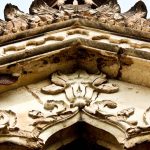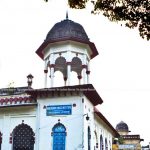Birbal Sahni
The Pioneer of Palaeobotany
Birbal Sahni was the pioneer of palaeobotanical research in India and is justifiably known as ‘the father of Indian paleobotany’. He not only brought reforms in the field of botany in India, but also gained international acclaim and recognition. Born at Behra, near Shahpur district (now in Pakistan), on 14th November 1891, he was an enthusiastic educationist and also worked for social causes.
His father Ruchi Ram was professor of Chemistry at the Government College, Lahore. Birbal Sahni has had an early influence of great people like Motilal Nehru, Gokhale, and Srinivasa Sastri who were friends of his father and often used to come to their home in Lahore. Sahni received his early education in the schools at Lahore. He was good at studies and showed an interest in plants from an early age. He obtained a degree in Botany from the Punjab University.
His mentor and guru was Prof. S.R. Kashyap, a great Indian botanist who played a significant role in shaping the life and interests of Birbal Sahni. Sahni also imbibed a love for Sanskrit, which relaxed as well as inspired him in all the times. After he obtained his graduation from Punjab University in 1911, his father professor Ruchi Ram Sahni arranged for young Birbal to go to England for higher studies. Birbal’s elder brother Dr. Bikramjeet Sahni was already there, studying in Cambridge. He got into Cambridge with some difficulties. Soon after he got in, young Birbal got homesick and fled the college to return to his brother in London. He was pretty disturbed by this incident. After much discussion and counsel, Birbal went back to England and from there on he never looked back. Sahni left for England in 1913, to study Natural Science Tripos, in the Emmanuel College, University of Cambridge. There he attended Prof. Albert Seward’s lectures and accompanied Jawaharlal Nehru who also moulded his scientific career.
Upon his return from England, after the completion of his education in Cambridge, young Birbal’s mother, Smt. Ishwari Devi, started giving serious thoughts on the matter of his marriage and broached the topic to him. He showed no resistance in response and left the choice of the bride completely in his mother’s hand. His mother wasted no time and decided upon Savitri Suri, daughter of an old family acquaintance Mr. Sundar Das Suri, as her daughter-in-law in 1920. Around 1919 in India, he taught in Banaras Hindu University for a year and another year he worked in Punjab University. In 1921, he was appointed as Professor of Botany at the University of Lucknow, where he continued to teach and motivate his students till 1949. Even after being given the administrative post of Dean of the department, he taught and worked on the field meticulously. To ensure balanced teaching and individual attention to each student, he insisted on small numbers at the M.Sc level, mostly not exceeding six students per batch.
He always gave a lot of importance to practical classes and motivated students to work on new research projects. By emphasizing on this, he built up a very active school of research in botany, which has had lasting impacts. As he was excellent at sketching, made detailed illustrations for better understanding of his students. The way he rapidly made comlpex diagrams using both his hands simultaneously drew much appreciation and awe. His unpretentious style and simple usage of English impressed thousands. One of his eminent students, Prof. T.S. Sadasivan (of Madras University) recalls how clear Professor Sahni’s accent sounded to the ears and even though he used lucid language, the impact was tremendous. He remembers Sahni’s lectures even today.
In the year 1929, he received the degree of Sc.D. from the University of Cambridge. He was also the first Indian Botanist appointed as Fellow, Royal Society of London (FRS) in 1936 – the most prestigious British scientific honor.
He wrote many scientific papers, the first paper was completed in 1915 and four more followed till 1919. His fame began right from his first research paper where he showed the presence of foreign pollen grains in the ovary of Ginkgo plant and inundated its importance in biological researches. His unparalleled work should have a mention of Necrolepus, Mepholobus Pexas, Psilotum, Masepteres and Acmopyle whose researches threw a light on the properties of growth and evolution, geographical distribution, the structure and their related sub-species. This research output culminated in the publication, jointly with J.C. Willis, of Lawson’s Textbook of Botany. For his major contribution to the study of fossil plants, Sahni received in 1919 the D.Sc. degree from the University of London. The thesis work was published in the Philosophical Transaction (1920), which led to Sahni popularly emerging as an original thinker of Botany.
Birbal Sahni’s interest in the rich fossil plants of India dates back to 1917, when he, with his Guru Seward, was in the process of bringing out a “Revision of Indian Gondwana Plants” (that finally came out in 1920). He had an undying interest in critically examining the collection of fossil plants in the Geological Survey of India. In the coming years he, along with his research students, discovered many new fossiliferous localities in the country. Most of these were not known for the availability of rich plant fossils before this.
He also used to study Geology and showed great interest in Archeology. His study of Geology acted as an extension to the study of Palaeobotany. It gave him a broader perspective and a wider understanding of his field.
In the words of one of his students, T. S. Sadasivan, “Simple looking in his handwoven khadi achkan, churidaar and Gandhi cap, he emanated elegance and great knowledge. Even after forty years of his passing away, we, the students of this enchanting Guru, have nothing but fond memories of the many years we were privileged to spend with such a one. His philosophy of life was one of attached detachment like a true Vedantin. Duty was his main forte.”
Sahni’s foremost ambition was to put palaeobotanical research in India on an organized foundation. Initially, he established a museum of plant fossils in 1929 for the benefit of those interested in the study. His collection of fossil plants from India and abroad, including those received by him as gifts, structured the beginning of the museum. Scientists have since then, continuously enriched the museum’s repository through collections during their fieldwork all over the country, as well as by receipt of material from foreign countries in exchange. Holotype specimens, slides and figured specimens are stored by the museum systematically and are readily available to research workers for investigation.
In 1939, he constituted a committee of Indian Palaeobotanists named as ‘The Palaeobotanical Society’ and convened a meeting to coordinate and develop research fields in India. The Governing Body of this society subsequently established the Institute of Palaeobotany in Lucknow, later to be named after Professor Sahni. This institute started functioning on 10 September 1946 at the Botany Department, Lucknow University, with Professor Sahni as its honorary Director. In September 1948, the Government of the state gifted him a piece of land next to Lucknow University. He made a comprehensive plan for the institute building on this land. Pandit Jawahar Lal Nehru laid the foundation stone of the building, the then Prime Minister of India, on 03 April 1949.
As if in a symbolic manifestation of an accomplished responsibility, Birbal Sahni passed away on 10 April 1949 – a week after the foundation stone was laid. The Governing Body of The Palaeobotanical Society appointed Mrs Savitri Sahni to serve the Institute as Director. Later in October that year, the Institute was christened as The Birbal Sahni Institute of Paleobotany.
The science of palaeobotany deals with study of past plant relics found in sedimentary rocks. Professor Sahni at the occasion of laying Foundation Stone laying ceremony of the Institute Prof. Sahni said:”Palaeobotany is the common ground between Botany and Geology – it is in fact the Botany of the rocks”. An integration of plant and earth sciences in the pursuit of palaeobotanical researches is the primary aim of this organization. Researches on various broad topical aspects, applied and basic both, supported by state of the art instrumentation, computational technology, well-equipped laboratories with qualified experts give a true meaning to this Fusion-Science. Interaction through National and International collaborations and different research projects are operational to achieve the desired goals.

Birbal Sahni Institute of Palaeobotany
Professor Sahni was highly admired and respected by academicians, scholars and people from other realms of life, from both India and abroad. His most significant achievements included many important positions that he upheld and awards that he received.
He was appointed as the President of Indian Botanical Society, which he, along with many others had founded. In 1940 he was the General President of the Indian Science Congress. He was a member of the Court of the Indian Institute of Science, Bangalore. He was the recipient of several prizes. The Universities of Cambridge, Allahabad and Patna conferred on him the D.Sc degrees (Honoris Causa). International recognition of his work came early in life. He was the Vice-President of the Sixth International Botanical Congress (Palaeobotany) held at Cambridge (1930) and Amsterdam (1935). He was elected President of International Botanical Congress at Stockholm (1950) but fate deprived him of accepting this honour.
He and his research made a base and enlivened the future prospects of Palaeobotanical research in India. He dedicated his life to science and refused many lucrative political offers that came his way. When invited by Maulana Abul Kalam Azad, free India’s first Minister of Education, for the post of Secretary to the Government in the Ministry of Education, he declined, confirming his fidelity towards science.
Sumbul Zehra
Writer is a student of Journalism and works as a freelance writer.
(Published in The Lucknow Observer, Volume 2 Issue 15, Dated 05 June 2015)




